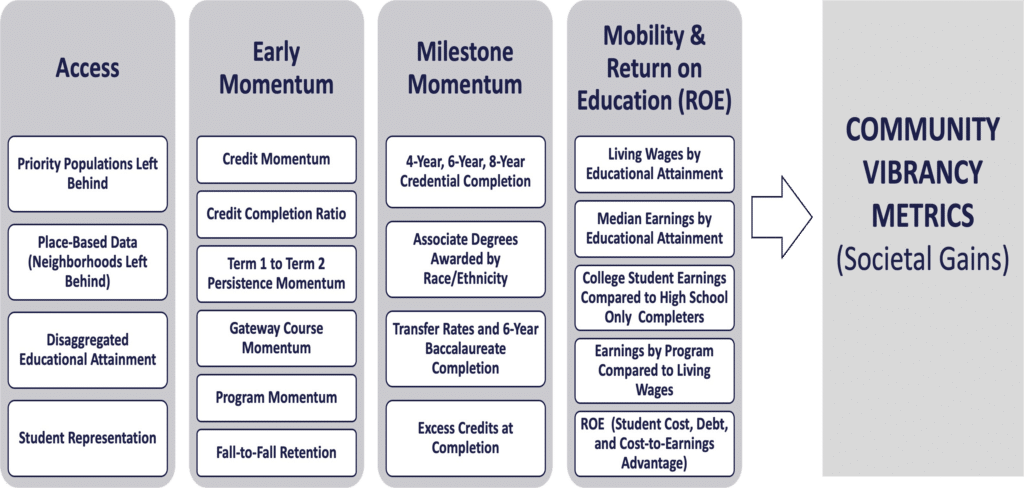Fifteen ATD Network colleges are using and helping refine ATD’s new transformational framework designed to connect access and credential attainment to economic mobility and community vibrancy. The ATD Community Vibrancy Framework is based on the belief that community colleges must think bigger and act urgently to address systemic inequities — at their institutions and in the communities they serve. Moving these efforts to the next level requires their leaders to see their students and communities in new ways and answer difficult questions:
- Who is missing from community college campuses and the programs preparing graduates for satisfying, family-sustaining careers?
- What is the college’s role in ensuring that its community is sustainable and economically vibrant for years to come?
- With whom can the college partner — or deepen existing partnerships— to better serve underrepresented learners and connect college transformation with what the community needs most?
“The framework is a new roadmap for community college sustainability, a pathway for ensuring relevance with value, and a redefining moment for what the student success movement is all about,” says Dr. Karen A. Stout, ATD’s president and CEO.
A new integrated model for institutional transformation, the framework is aimed at expanding access to higher education, creating greater social and economic mobility for more learners and their families, and helping communities flourish across a broad range of measures.
“The community vibrancy work is the next phase of the student success movement, answering the question — success to do what?” says Chris Whaley, president of Roane State Community College. “We want to help students get a job, have a family-sustaining career, and be more well-rounded citizens. Ultimately what we want is for enough of those folks in a community to have economic and social mobility so that we’re not just lifting up one or two individuals, but hopefully, through the work that we do in partnership with the local community, we are lifting up the entire community. We can’t do that on our own, but we certainly have an important role and responsibility.”
Localized approaches and lessons learned
Serving 200,000 students across a dozen states, the initial Community Vibrancy cohort of 15 colleges reflects the sector’s diversity, including in its ranks small, large, rural, urban, technical, and tribal colleges. While each college’s context is different, all have found community vibrancy reflective of their missions and strategic goals — and a tool to help advance them in new ways.
Through the Community Vibrancy curriculum and coaching, ATD and the 15 cohort colleges are working to understand local communities in ways that will lead to upward mobility for individuals and their families and help communities flourish and thrive economically. They are also expanding the use of data from local, state, and national sources to create a more comprehensive picture of what the future might look like if community colleges reached their potential to serve more students in better ways as part of the drive to improve student success.
To date, cohort colleges have leveraged the framework to do the following:
- Inform and give new context to strategic planning
- Identify and target specific populations left behind by postsecondary education, including adult learners and justice-impacted populations
- Improve access through advising and new talent pipelines
- Sustain institutional momentum, including redesigning the first-year experience and introducing new performance measures and metrics
- Promote economic and social mobility by leveraging community and labor market data to inform career advising, program relevancy, and new program development
- Support vibrant communities by participating in broader efforts to improve communities’ overall vitality
“These 15 case studies offer a look into the future of community college reform,” says Dr. Stout. “Each story offers a new vision for how our student success efforts must move beyond completion for our work to activate the kind of student and community transformation that we seek as a sector.”
An inside-out/outside-in model for transformation
The framework helps colleges anticipate and account for transformation by looking not just inside-out but also outside-in. College leaders must deeply understand students and how transforming institutions supports their success and influences communities, while at the same time see their communities in new ways to understand how their context influences and informs the work community colleges do to support student success.
The ATD Community Vibrancy Framework holds college and community transformation in mind simultaneously to help community colleges become learning, credentialing, and economic mobility hubs that eliminate inequities in college and workforce outcomes. It is in the intersection of the inside-out and outside-in approach where new possibilities abound.
ATD looks forward to expanding this work across its network of colleges and beyond as it makes the framework the backbone of its approach to innovation, coaching, and service delivery.
For more information, visit ATD’s Community Vibrancy page.

